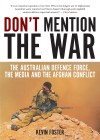Don’t Mention the War: The Australian Defence Force, the Media and the Afghan Conflict
Written by: Kevin Foster,
Monash University Publishing, 2013,
ISBN 9781922235183, 168pp
Reviewed by: Tom Hill
Kevin Foster’s Don’t Mention the War seeks to explain the lack of objective and erudite reporting on the Afghanistan conflict by the Australian media, arguing that the coverage was characterised by an absence of insight and investigation. Instead, the media were forced to perpetuate the ADF’s strategic and operational narrative to the detriment of public discourse and debate. In support of his argument, the book analyses the ADF, government and media’s attitudes to reporting in Afghanistan. His analysis reveals a complex interplay of factors which conspired, directly and indirectly, against transparent and unbiased reporting of the war. As a result the book provides a comprehensive understanding of the array of factors behind the low standard of reporting. However, the reader is left to deliberate the effect of the collective failure to provoke insightful and objective debate in Australian public discourse on the quality and legitimacy of the ADF’s participation in the Afghanistan war.
Foster’s book is situated within the well-established debate on the influence of the ‘4th Estate’ on political decision-making. His work provides fresh insights into its relationship with the ADF and how this distrustful and at times antagonistic relationship restricted objective reporting on the Afghan conflict. He begins his analysis by questioning the legitimacy of ADF attitudes to reporting, citing the long shadow cast by negative attitudes to the media during the Vietnam War.
He contends that this unjustified negativity reflected the attitude of American forces to the media at the time. This was reinforced by the frequent substitution of American content for Australian by the better resourced American broadcasters. Suspicion has continued to dominate the ADF’s approach to the media despite the passing of time.
Foster asserts that this perception continued to underpin the ADF’s media engagement with journalists in Afghanistan. Its effect was most pronounced in the media embedding program. He argues that the program lacked structure and an established agreement between the ADF and media organisations. Consequently, it was susceptible to the personalities and attitudes of Defence personnel which limited journalists’ exposure to the ADF’s work. He contrasts this with the embedding program conducted by Canadian and Dutch forces. Apart from the political and cultural issues which drove their engagement with the media, Foster emphasises that their success was built on a willingness to formalise mutually beneficial relationships which, he asserts, the ADF lacked.
Foster also focuses on the shortcomings of both the media and the public.
The Australian media’s unwillingness to invest in overseas bureaus — due largely to falling revenues linked to the modern revolution in media — tended to restrict original reporting. Furthermore, the public lack of interest or propensity to question the reasons and strategy behind Australia’s involvement in Afghanistan limited the conflict’s commercial media appeal. This stable public support for the war, Foster argues, was nurtured by the ADF and the Defence Minister’s office through a constant, ADF-generated strategic narrative.
Foster’s analysis weaves through a complex interaction of historical, cultural and political arguments to support his central thesis. However his detailed handling of the multifaceted and broad-ranging issues which made objective and insightful reporting in Afghanistan challenging makes close reading necessary. The reader can get lost in his often long and convoluted sentences. This makes the book slightly unfriendly to a non-academic audience and is exacerbated by the lack of a dominant narrative at some points. Given the complexity of the issue, a stronger central narrative would have helped bind many of the interrelated issues.
However the book’s central argument is consistently well supported and convincing. Foster’s use of evidence based on face-to-face interviews and academic research reinforces an already widely held assumption that reporting on Afghanistan lacked objective insight. Foster’s book neatly explains why objective reporting on the war was constrained. He ties together shortcomings within the ADF, media and government and signals a collective failure to objectively inform the public on Australia’s longest war. Don’t Mention the War is insightful reading for those who seek to improve the quality of media coverage of any future operation conducted by the ADF.

